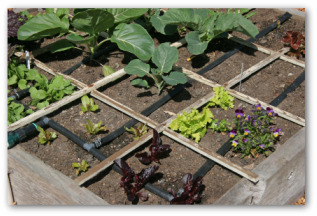Growing your own vegetables is a very rewarding and delicious experience! When we excitedly peruse our seed catalogues during those long dark days of winter, this is our opportunity to choose which delicious edibles will suit our gardens and families best. However, it is easy to get caught up in dreams of growing a huge bounty of large broccoli florets, sweet juicy ears of corn, and tons of red bell peppers. Although this is entirely possible, they may not be the most practical choices if we are looking to maximize our harvest. In this article you will learn some proven strategies that will help you grow more and work less!
Whether you're dealing in acres or square feet, a discerning crop selection strategy is one of the most important skills that you can apply to your gardening. But what does it mean to mindfully select your crops? Simply put, it means that you will be choosing plants that will yield the highest return given your time and space constraints. The first step to practising mindful crop selection is to know your garden. How much space is available? How much light does it get? Are there any frost pockets, or any places that are particularly dry or wet? Once you have surveyed your garden space, it's then time to ask yourself what types of vegetables you and your family would like to eat and which ones will grow best given your conditions. To help guide the process, I have listed the criteria that I use when discerning what crops will work the best for me each season:
1. One Time Harvest vs Multiple Harvest
Will you be able to continually harvest leaves and/or fruit for many days, weeks or months? Both one-time harvest and continual harvest plants are valuable in the garden. It is important when designing your garden for maximum output, to know how long it takes for a plant to reach maturity and, how long that plant will produce a viable harvest. As an example, lets consider broccoli. Annual broccoli plants take about 90 days to reach maturity, will produce one main floret and require 1 square foot of garden space per plant. In contrast, tomatoes reach maturity in 60 days, offer a long generous harvest and can be planted densely with up to 3 plants per square foot! Need I say more?
2. Environmental Needs
Do the sun, water, and soil requirements of your plants match the conditions in your garden? Will you need to put time and energy into landscaping your garden to match the needs of the plant? This criteria is of vital importance. It can mean the difference between a great crop and the worst crop ever! The area under the overhang of your house will serve as our example. It is dry and often warm under overhangs. Therefore, planting your fresh spring greens or radishes here would require extra time and attention to ensure a fresh tasty harvest. On the other hand, cucumbers and tomatoes would love the protection from the rain and all of that warm residual heat thus thriving with little need for that extra care on your part. So before you sow your seeds or plant your seedlings, make sure it's in the right place for them to thrive and save yourself all that time, effort and frustration!
3. Space Optimization
Home gardeners often sow their seeds according to the directions given on the seed packet. These directions generally recommend row spacing, which is great, if you're farming in Chilliwack. However, in our urban home garden setting, planting in rows leads to more pathways than tasty food to eat. But fortunately, we can increase our productivity and make use of those pathways. Knowing how large your plant will get, is an important part, and this is where square foot gardening comes in. Within one square foot of garden soil, you can grow 32 radishes or 16 medium sized carrots, beets or onions, or up to 4 cucumber plants! In addition to packing your plants in for some healthy competition, it is important to know which plants grow well together. A delightful edible companion planting is a sunflower with beans and cucumbers trellised up the stalk, and a tasty mix of peas, radishes and dandelion underfoot. All of these plants are utilizing different areas of the soil, as well as different layers of the above ground canopy. To top it off, the peas and beans are readily fixing atmospheric nitrogen, and the dandelion is actively bringing up rich minerals from deep in the soil which benefits the whole planting. Just imagine how wonderful that bright, beautiful and delicious combination will be!
So, before you begin planting your veggies this year, make sure they are ones that will provide you with the most reward for your valuable time and effort. After all, you're worth it! If you would like to learn more about these practices I recommend checking out the following resources:
- All New Square Foot Gardening by Mel Bartholomew: this comprehensive book will help you get the most out of every square inch of your garden!
- How to Maximize Your Balcony Harvest: this workshop at VanDusen is a great introduction to small scale intensive gardening.
- Companion Planting Chart - http://www.figtree.org.au/companion planting.html - this reference table offers guidance on which plants like growing together and which ones don't.
Good luck in your gardens! I hope this will be a rewarding year full of fresh abundant home grown veggies for you and your family. Bon appetit!
Katherine Oblock
Master Gardener in Training, Vancouver Chapter





